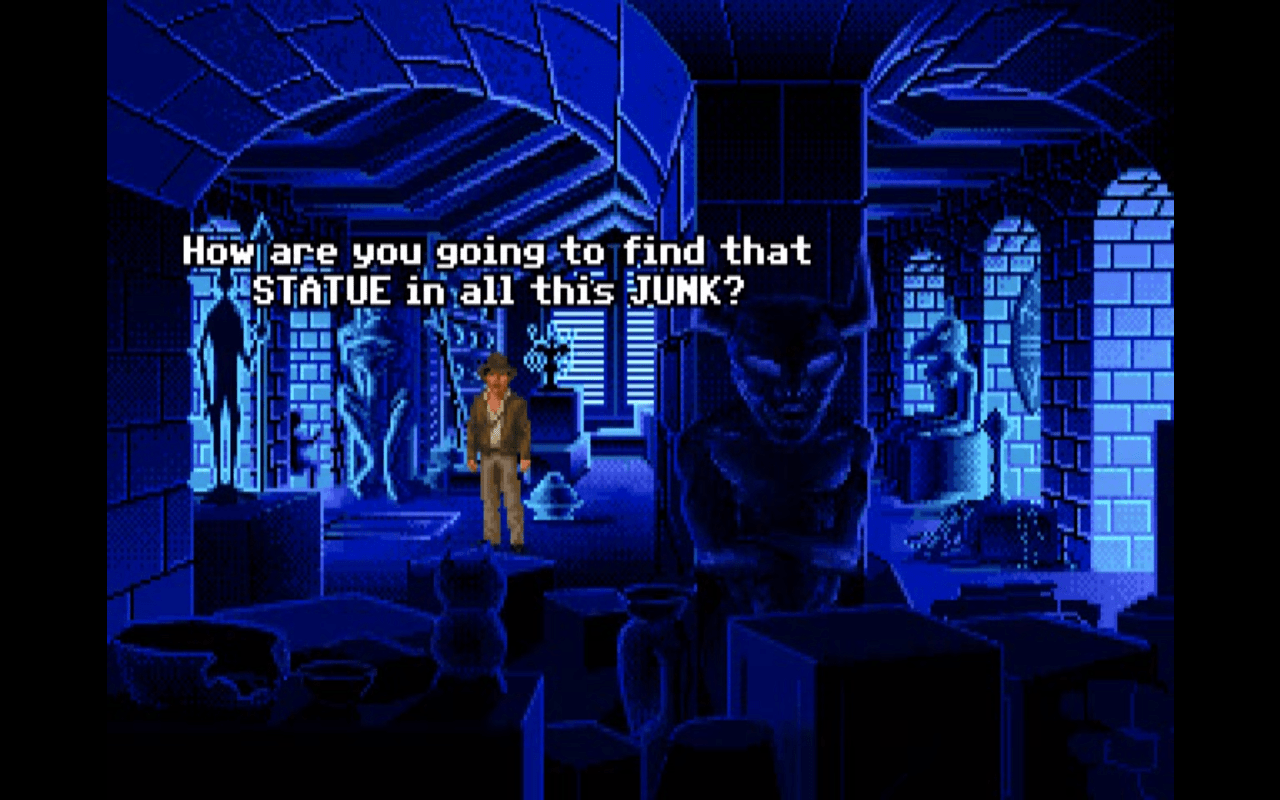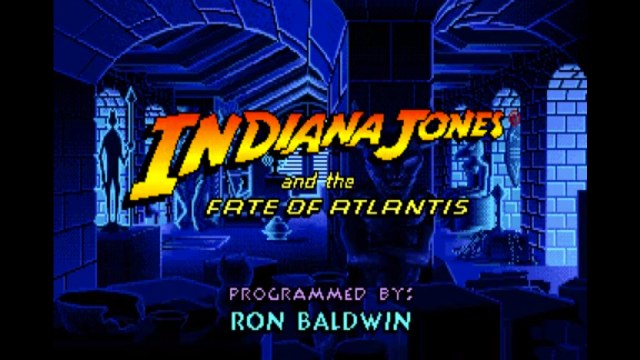Indiana Jones and the Fate of Atlantis has a part, in the beginning, where you can play the initial titles or credits sequence at the beginning of the game. I find myself wishing that way more narrative-based games would do this adorable moviesque thing.
I write a column over at Rock Paper Shotgun called ‘S.EXE‘ which is about sex and relationships in video games, and I played through the classic point-and-click adventure game Indiana Jones And The Fate Of Atlantis a while back to write about the equal and really quite wonderful screwball comedy relationship between Indy and his paramour Sophia.
Because Fate of Atlantis is based on the Indiana Jones movie franchise, there must have been some pressure at the time to fit in with the ‘existing brand’, in that kind of horrible commercial-speak that must have, at some point, come up. Happily the developers at LucasArts at this time were some of the most creative in the industry, and many of the obstacles that they might have come across trying to get across the effervescent pop and fizzle of Indiana Jones movies were solved with considerable inventiveness and joy.
What’s most magnetic to me about Fate Of Atlantis in particular is the attention to the world of Indiana Jones, and the game opens in Barnett College, a place often shown in passing in Indiana Jones movies, but it is never much of an action location itself. I mean, why would it be, when Indiana Jones spends so little time actually… uh… teaching and more sort of… punching Nazis in the face. The care and love that is clearly shown for the “lore” of the Jones universe is clear though, and it’s particularly clear from the titles sequence.
There’s a little midi drumroll and the classically-fonted INDIANA JONES appears in the familiar orange and yellow font. The classic score from John Williams plays (in MIDI). Some credits appear. Then Indiana Jones smashes through a window into the attic You can explore the attic by clicking on various objects, and Indy will contextualise your surroundings – there something Marcus thought was from a Masai warrior, there’s a statue of Kali. You understand that your character – if you’d never encountered him before – is some sort of historian in an odd hat. If you step on the trapdoor in the room, you fall through to the next part of the sequence.
That’s great narrative design — the player is put in a context where they have to look at objects to “get to the next level”, which means that they get a semblance of who they are and where they are. Each time you drop or escape from a room in this particular intro sequence, there’s a sense that you are getting to know your past, where you hang out, what the game expects of you in rapid succession because so many environments need to be investigated in a small amount of time.

But the actual participation in a movie-like credits sequence is pleasing because there’s a sense that you are literally moving the plot along, that you are participating in a story that you are making – and not only that, that you are doing it stylishly, and the game is waiting for you to do it. The fact that the rest of the credits are triggered is a very simple reward that says, “You did OK, kid, good job.” You feel included, even though, really, the fourth wall is being broken. It’s really being pointed out that this game is an artifice: you are playing a game that wants to be a movie, and here you are ‘making’ the credits sequence function.
I also really love the fact that the soundtrack hopefully waits for you, treading water until it can punch you back in.
I’m not sure every developer could pull this off, but Fate of Atlantis pulls it off so well and so effortlessly that I find myself craving more games that might imitate film in a way that isn’t a cut scene or a voiceover. A developer I stayed with and wrote about last year, Brendon Chung, is notable for his movie aesthetic in his games – ones such as Quadrilateral Cowboy and Thirty Flights Of Loving (which he made with my friends at Idle Thumbs) – where he uses what are really game smash cuts.
There are a lot of innovative film techniques that games could be borrowing from that we simply have never thought of using to move game narratives on. Recently Brendon even remarked that he thinks games should use more cold opens:
I love the video game cold open. No menus, no titles, no splash screen, no movies. Let me play your game. Good example: Infinifactory
— Brendon Chung (@BlendoGames) April 8, 2015

Comments
4 responses to “Fate Of Atlantis And Movie Techniques In Games”
X Men 2 Clone Wars on Mega Drive has a cold open, I wouldn’t call it a cinematic tour de force.
Cold opens don’t work so well for me at home since netflix needs a few minutes to buffer up to good quality
30 flights of loving and gravity bone are pretty awesome. They are incredibly short, but still compulsory playing. I’d love to see a full length game that was slightly less linear.
man this really is one of the greatest games of all time, no clue why we didn’t get a Star Wars point and click adventure game 🙁
Need to play Fate Of Atlantis and The Dig.
I like the ‘Half Life’ open – interactive cinematics, where you get to control the character and look around, but still get the contextual explanations that most games convey through cutscenes. Not quite as interactive as IJ:FoA, but still better than most.
This was one of my most favorite adventure games as a kid growing up with a PC. There were so many good adventure games around this time, besides the obvious (Monkey Island, Hero Quest, Kings Quest games) another stand out for me was “Quest for the longbow – The legend of Robin Hood” one of the best Robin Hood stories ever done. I wish they made Fate of Atlantis into a move though!!!